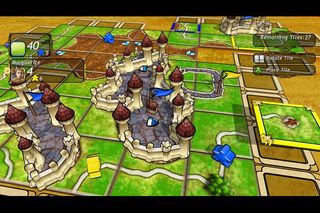What is Carcassonne?
Popular German board game heading to XBLA, tabletop geeks rejoice
For those unfamiliar with Carcassonne, it started in 2000 as a German board game inspired by the medieval French city of the same name. While it may not yet enjoy mainstream success, Carcassonne has already gained an almost cult following, for its classic gameplay and simple charm. If you've never played this gem, this June is the time to check it out when it heads to Xbox Live Arcade.
The game consists of 72 tiles that each make up a section of a medieval landscape, and include features like roads, cities, farms, and monasteries (or cloisters, if you prefer). Players take turns picking tiles at random and placing them adjacent to other tiles on the board. The only rule is that tiles must be placed in a way that makes sense: cities must be enclosed with proper borders, rivers can't suddenly end and become farm, and so forth.
The gameplay is easy to pick up (the included tutorial will give you a complete briefing in under five minutes), but building a winning strategy can take much longer. Players score points by completing cities, and placing their "followers" (little game pieces you can place on your tile during your turn) on roads, farms, and monasteries.

Above: Completed cities appear in 3D splendor, while uncompleted ones are represented by that brown area
For the most part, Carcassonne is a civilized game, but matches can get nasty depending on how you want to play it. Players can poach each others' cities (fill in the last piece of a city that another player has been working on to steal their points), cut off each others' farms, and otherwise foil their opponents' hard work. Or, you can play nice and just focus on your own cities, roads, and so forth, leaving your opponents' work alone. Be careful, as Carcassonne has been known to break up as many friendships as it has brought together.
The XBLA version is faithful to the original board game, with only small adjustments here and there. When deciding where to place a tile, only legal moves are shown, which newcomers will find helpful, as the range of options is sometimes overwhelming at first.
Sign up to the GamesRadar+ Newsletter
Weekly digests, tales from the communities you love, and more
One advantage that the XBLA version of Carcassonne can boast over the original board game is that the tiles can now have dynamic art - on the XBLA version, monasteries jump out from the board when completed, cities bloom with life, and roads appear to solidify. As you expand your kingdom throughout the game, it will appear to take on life and texture, as opposed to the visual limitations of static board game tiles.

An incredible XCOM-like strategy game is finally getting a sequel after 9 years - the latest in a criminally slept-on series that's never seen a bad game

The latest unexpected Steam hit is a $3 must-play and it may still hit greater heights after nearly 7,000 glowing reviews as the dev looks to add multiplayer
Most Popular








